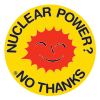
Back Невада — Сяміпалацінск BE Nevada Semipalatinsk Czech Nevada-Semipalatinsk EO Mouvement antinucléaire au Kazakhstan French Невада-Семей KK Międzynarodowy Ruch Antynuklearny Nevada-Semipałatyńsk Polish Невада — Семипалатинск Russian Невада — Семипалатинськ Ukrainian

| Anti-nuclear movement |
|---|
 |
| By country |
| Lists |
The anti-nuclear movement in Kazakhstan, commonly known as Nevada-Semipalatinsk (Russian: Невада-Семипалатинск; Kazakh: Невада-Семей, romanized: Nevada-Semei), was formed in 1989 and was one of the first major anti-nuclear movements in the former Soviet Union.[2] It was led by author Olzhas Suleimenov and attracted thousands of people to its protests and campaigns which eventually led to the closure of the Semipalatinsk Test Site in north-east Kazakhstan in 1991.[3][4][5] The movement was named "Nevada Semipalatinsk" in order to show solidarity with similar movement in the west of the United States aiming to close the Nevada Test Site.[6]
The Soviet Union conducted 456 nuclear weapons tests at the Semipalatinsk Test Site, between 1949 and 1989.[5][7] The United Nations believes that one million people around Semey were exposed to radiation, and the incidence of birth defects and cancer is much higher than for the rest of the country.[3][4][5]
According to UNESCO, Nevada-Semipalatinsk played a positive role in promoting public understanding of "the necessity to fight against nuclear threats".[8] The movement gained global support and, became "a real historical factor in finding solutions to global ecological problems".[8]
Astana hosted an international conference Building a Nuclear-Weapons-Free World in August 2016.[9] The topics of the conference included nuclear non-proliferation and disarmament and the physical protection of nuclear weapons. The main outcome of the conference was the adoption of The Astana Vision Declaration “From а Radioactive Haze to a Nuclear-Weapon-Free World.”[10]
- ^ Togzhan Kassenova (28 September 2009). "The lasting toll of Semipalatinsk's nuclear testing". Bulletin of the Atomic Scientists.
- ^ Kassenova, Togzhan (2022). Atomic Steppe: How Kazakhstan Gave Up the Bomb. Stanford University Press. ISBN 978-1-5036-2846-5.
- ^ a b "BBC News | Asia-Pacific | Kazakh anti-nuclear movement celebrates tenth annoversary". news.bbc.co.uk. Retrieved 2024-01-10.
- ^ a b "Inside the nuclear underworld: Deformity and fear - CNN.com". edition.cnn.com. Retrieved 2024-01-10.
- ^ a b c Krech III, Shepard; Merchant, Carolyn; McNeill, John Robert, eds. (2004). Encyclopedia of World Environmental History. Vol. 1: A–E. Routledge. pp. 70–71. ISBN 978-0-415-93733-7. Retrieved November 23, 2012.
- ^ King, Hannah. Kazakhs Stop Nuclear Testing (Nevada-Semipalatinsk Antinuclear Campaign), 1989-1991. Global Nonviolent Action Database, Swarthmore College, 29 Nov. 2010. Accessed 14 July 2013.
- ^ "Semipalatinsk: 60 years later (collection of articles)". Bulletin of the Atomic Scientists. September 2009. Archived from the original on 2009-10-14. Retrieved 2009-10-01.
- ^ a b Kazakhstan - Audiovisual documents of the International antinuclear movement “Nevada-Semipalatinsk”. portal.unesco.org, Archived 2005-11-06 at the Wayback Machine
- ^ "International Conference: Building a nuclear-weapon-free world | Astana, Kazakhstan, 28–29 August 2016". Retrieved 2023-06-07.
- ^ "Anti-Nuclear Weapons Leaders Adopt "Astana Vision Declaration" at Int'l Conference in Astana". astanatimes.com.